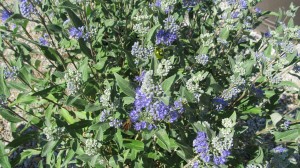Blue mist spirea or bluebeard (Caryopteris x clandodensis) is not commonly planted in U.S. landscapes. In mid- to late- summer, pale blue flowers open above the gray-green foliage. Leaves and stems are mildly aromatic to the touch. There are now several good hybrid forms, thanks to plant breeders’ efforts to improve garden performance.
Caryopteris (I prefer this name) grows in average soil, preferably slightly acidic, and wants very little extra care. Although moderately drought tolerant, don’t allow it to suffer through a prolonged dry spell without irrigation. Cold hardy to USDA hardiness zone 5 (perhaps 4 with some protection), branch tips may die back 30-40% over winter.
Some plant experts classify caryopteris as a hardy perennial and treat it as such. Shoot injury may become noticeable in early spring, necessitating pruning. The easiest solution is to severely prune back the entire shrub in late winter.
This shrub recovers rapidly from cutting back. The technique is simple, not time saving, and doesn’t require reading a pruning book. It results in a compact growing, space-saving shrub.
Caryopteris may open hundreds of blooms at any time over a 6-8 week period from late summer into fall. Caryopteris suffers from very few disease and pest problems, including deer feeding.
Its flowers and gray-green foliage (select varieties) are prized by florists who utilized them in fresh and dried flower arrangements. Fresh keeping quality often lasts 7 days and longer.
Many hybrid cultivars are available, including two favorites:
‘Worcester Gold’ – solid gold foliage and pale blue flowers.
‘Dark Knight’ – deep blue flowers on 3-4 foot compact plant.


 Posted in
Posted in 
